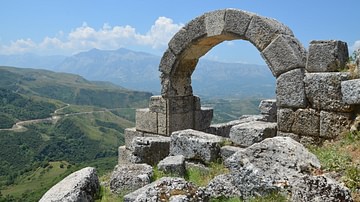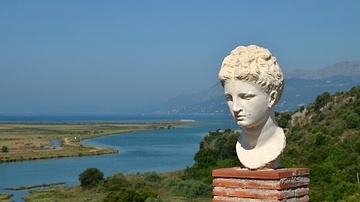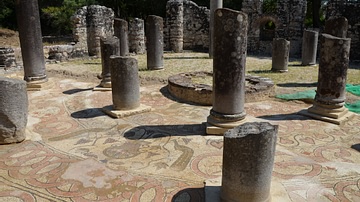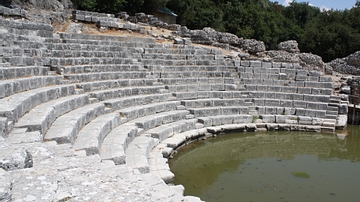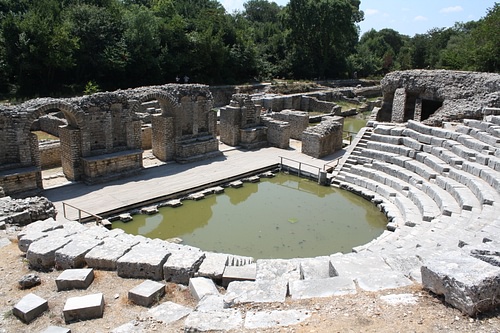
Butrint (ancient name Buthrotum) is located on the fertile coast of Epirus in present-day Albania and was an important settlement in Hellenistic and Roman times due to its position on the route from Italy to mainland Greece down the Ionian Sea, its safe anchorage, inland access via Lake Butrint and its proximity to Corcyra (Corfu). Butrint is a UNESCO World Heritage Site.
Greek Butrint
Settled since the Bronze Age, the site was certainly in contact with the Greek civilization from the 7th century BCE as pottery finds from Corinth and Attica attest. Indeed, archaeological remains suggest that an archaic temple sanctuary was present on the site from the 5th century BCE, possibly in honour of Zeus Soter. Polygonal fortification walls also remain from this period. In all probability, Butrint was at one time a colony of the ancient city of Corcyra, just a few kilometres across the sea on the island of Corfu. From the 4th century BCE, it is likely that Butrint became subject to the Chaonians, who controlled the Epirus region and had their capital at Phoenice.
Hellenistic Period
In Hellenistic times from the 4th to 3rd century BCE, fortifications consisting of a circuit wall of large rectangular cut blocks was constructed with various monumental gates. A large sanctuary to Asclepius was also constructed on the southern slopes of the acropolis, probably around a sacred spring. In the 2nd century BCE, the site was extensively developed with funding from offerings made at the sanctuary and many buildings were constructed including a theatre and agora with stoas.
Roman Period
Butrint came under Roman control in 167 BCE but maintained a high degree of autonomy. The Romans gave Butrint particular importance via the Aeneid of Virgil which had the hero Aeneas stay at the site and attributed a Trojan ancestry to the town, claiming the settlement was founded by the seer Helenus, son of the Trojan King Priam. Julius Caesar visited Butrint in 44 BCE and in 48 BCE it formally became a Roman colony. Butrint was not only strategically important in controlling local sea routes but was also of commercial interest in terms of agriculture. Indeed, the millionaire Titus Pomponius Atticus had owned property in the area from c. 68 BCE.
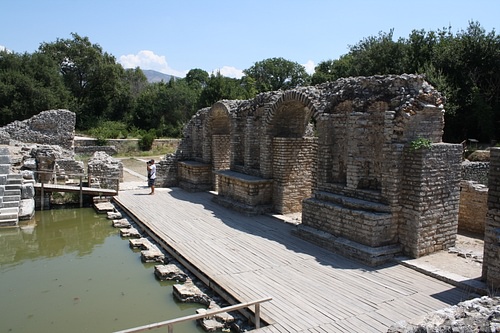
The town once again received Roman investment in the Augustan period after Augustus' victory in 31 BCE over Mark Antony and Cleopatra at the Battle of Actium, just 100 km to the south. Butrint officially adopted the Latin language, established a senate and was given the right to mint coins. Various building projects were instigated including Roman baths with underfloor heating, a road bridge, a nymphaeum (public decorative fountain), an aqueduct, three shrines - one dedicated to Minerva Augusta - and the paving of the agora and adaptation into a Roman forum. From the 1st century CE, the outer suburbs of the town were also further developed and its grid road system was typical of Roman town planning.
In the 2nd century CE, the theatre was expanded with the stage area being monumentalised and the forum was further beautified with shrines and dedicatory statues. From the 2nd to the 3rd centuries BCE the outer suburbs of the ancient city saw the construction of large private villas with large central peristyle courts, ornamental pools, and fine mosaic floors. Extensive architectural damage occurred to various buildings on the site sometime in the 4th century CE and may have been caused by the large earthquake of 365 CE which struck the whole Balkan area. Despite some evidence of reconstruction attempts, the site never recaptured its former prominence and, from the 5th century CE, Christian buildings were constructed including a large basilica and baptistery.
